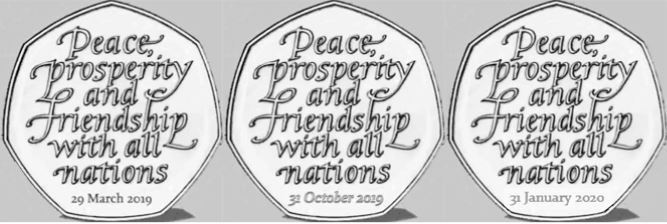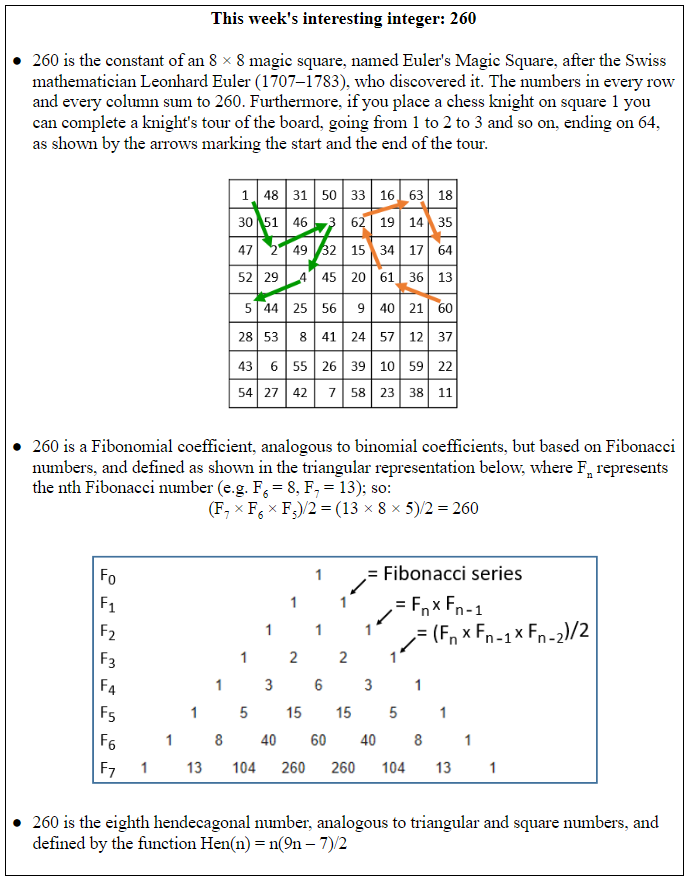 In his inaugural Presidential address on 4 March 1801 Thomas Jefferson enunciated what he called “the essential principles of our government”. The list (see the Box) included “Peace, commerce, and honest friendship with all nations”, of which the inscription on the new 50 pence piece celebrating the UK’s departure from the EU, “Peace, prosperity and friendship with all nations”, is a variant. Jefferson’s text reminds us of another principle, “absolute acquiescence in the decisions of the majority”. And replacing “commerce” with “prosperity” may reflect the fact that trade agreements have yet to be reached. The first coins to be minted were dated 29 March 2019, but Brexit was postponed and production was halted; two other versions (31 October 2019, and 31 January 2020) have since appeared (Figure 1).
In his inaugural Presidential address on 4 March 1801 Thomas Jefferson enunciated what he called “the essential principles of our government”. The list (see the Box) included “Peace, commerce, and honest friendship with all nations”, of which the inscription on the new 50 pence piece celebrating the UK’s departure from the EU, “Peace, prosperity and friendship with all nations”, is a variant. Jefferson’s text reminds us of another principle, “absolute acquiescence in the decisions of the majority”. And replacing “commerce” with “prosperity” may reflect the fact that trade agreements have yet to be reached. The first coins to be minted were dated 29 March 2019, but Brexit was postponed and production was halted; two other versions (31 October 2019, and 31 January 2020) have since appeared (Figure 1).
|
Jefferson’s “essential principles of our government”; published in the National Intelligencer, 4 March 1801; recorded in the Library of Congress TJ papers, 110:18838 “Equal and exact justice to all men, of whatever state or persuasion, religious or political:—peace, commerce, and honest friendship with all nations, entangling alliances with none:—the support of the state governments in all their rights, as the most competent administrations for our domestic concerns, and the surest bulwarks against anti-republican tendencies:—the preservation of the General government in its whole constitutional vigor, as the sheet anchor of our peace at home, and safety abroad: a jealous care of the right of election by the people, a mild and safe corrective of abuses which are lopped by the sword of the revolution where peaceable remedies are unprovided:—absolute acquiescence in the decisions of the majority, the vital principle of republics, from which there is no appeal but to force, the vital principle and immediate parent of the despotism:—a well-disciplined militia, our best reliance in peace, and for the first moments of war, till regulars may relieve them:—the supremacy of the civil over the military authority:—economy in the public expense, that labor may be lightly burthened:—the honest payment of our debts and sacred preservation of the public faith:—encouragement of agriculture, and of commerce as its handmaid:—the diffusion of information, and arraignment of all abuses at the bar of public reason:—freedom of religion; freedom of the press; and freedom of person under the protection of the Habeas Corpus:—and trial by juries impartially selected”. |

Figure 1. Three different versions of the “Brexit” 50 pence coin
Clearly Jefferson meant making peace with all nations, having commerce with all nations, and forging friendship with all nations. But in the reworked motto, “prosperity with all nations” makes no sense, and since prosperity comes between “peace” and “friendship”, it is not clear whether “peace” is on its own or is also linked to “with all nations”.
Controversy has also arisen from the fact that the motto contains only one comma, after “Peace”, as highlighted in a tweet from Philip Pullman: “The ‘Brexit’ 50p coin is missing an Oxford comma, and should be boycotted by all literate people”. Pullman lives in Oxford.
The Oxford comma is a comma that immediately precedes any of the conjunctions “and”, “or”, or “nor” before the last item in a list of three or more. It has a long pedigree, and examples can be found, for instance, in Shakespeare. It was originally called a serial comma, and although it also bears the name of Oxford, it has been espoused more in America than in Britain. For instance, the influential Manual of Style, first published by the University of Chicago Press in 1906, mandated the use of the serial comma, referred to in its index as “series, use of comma before final ‘and,’ ‘or,’ and ‘nor’ in,”; notice how the index entry obeys the imposed rule. And the first recorded instance of “serial comma”, according to the Oxford English Dictionary, comes from 1922, in an American newspaper, the Boston Globe. An alternative term, the “Harvard comma”, from its use by Harvard University Press, features in some dictionaries, such as Merriam-Webster and Oxford’s Lexico, although not the OED.
The term “Oxford comma” was introduced much later. The first recorded instance is in Peter Sutcliffe’s “informal history”, The Oxford University Press (Oxford at the Clarendon Press, 1978). There he recounts how Frederick Howard Collins (1857–1910), the author of Author and Printer (1905), later known as The Authors’ and Printers’ Dictionary, “invented the ‘Oxford comma’, for which he received support from Herbert Spencer.” But in fact Spencer may have been the true progenitor, as the extract from Collins’s book suggests (see Table 1), for Collins quotes fully from a letter that the late Herbert Spencer had sent him, justifying, in a particular instance, the use of what is now called the serial comma.
The chief reason for using the Oxford comma is not to emphasize, as Spencer implied, but to avoid ambiguity. For example, contrast “She went out with her two lovers, Boris Johnson and Nigel Farage” and “She went out with her two lovers, Boris Johnson, and Nigel Farage”. The first implies two or four people; in the second an extra comma removes the ambiguity. But the comma doesn’t always help. Consider “She went out with her lover, Boris Johnson, and Nigel Farage”. Is that two or three people? The Oxford comma makes it ambiguous.
The Table lists what various authorities, some qualified, a few self-appointed, have said on the subject, showing the diversity of opinions. But the debate about this trivial matter distracts from the real challenge, which is to write sentences that are unambiguous. Punctuation should not be prescribed by rote; it should contribute to the sense of the sentence. The motto on the 50 pence piece is grammatical (in the way that Noam Chomsky’s fabrication “green ideas sleep furiously” is grammatical) but badly written; no amount of punctuation will save it.
Perhaps the best thing to be said about the Oxford comma comes from Mary Norris, the self-styled “Comma Queen”, in her book Between You and Me (W W Norton, 2015). Wondering why alphabet soup contains only letters, she suggested that it would be a good idea if such soups also included punctuation marks, including a cereal comma.
Table 1. What others have said about the serial (Oxford or Harvard) comma, with my own comments and summary

Jeffrey Aronson is a clinical pharmacologist, working in the Centre for Evidence Based Medicine in Oxford’s Nuffield Department of Primary Care Health Sciences. He is also president emeritus of the British Pharmacological Society.
Competing interests: None declared.

